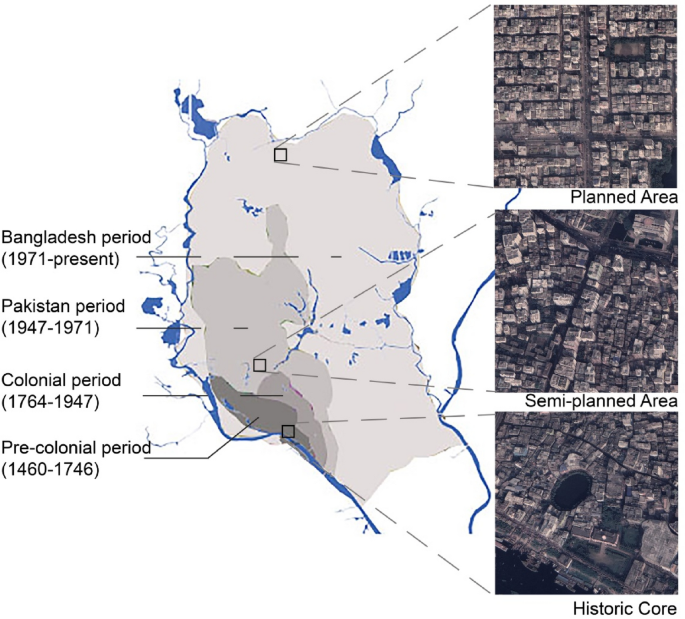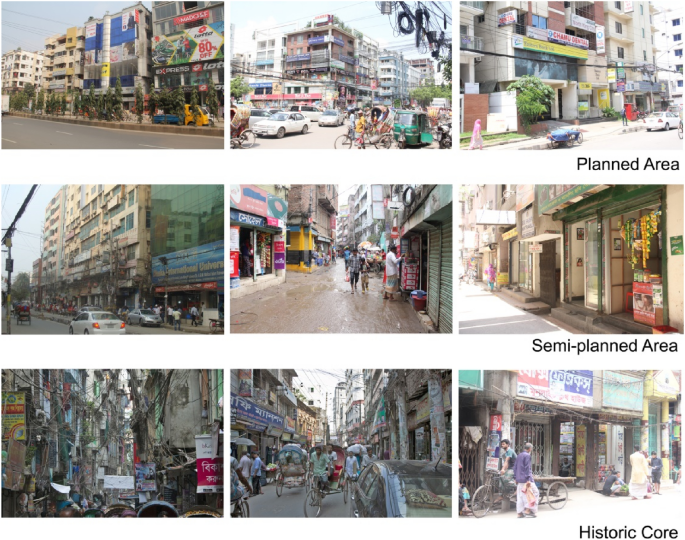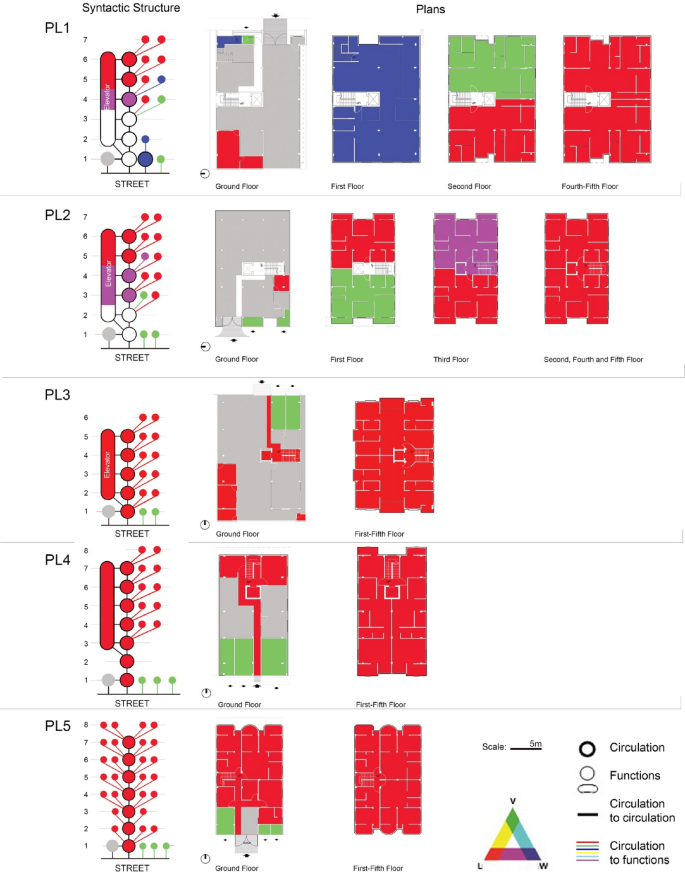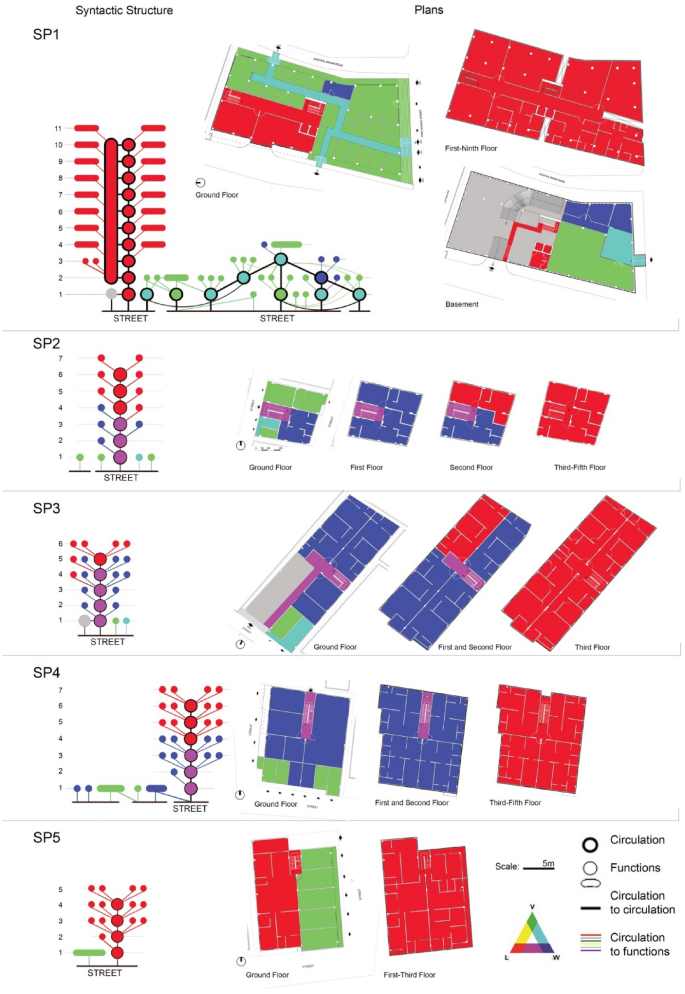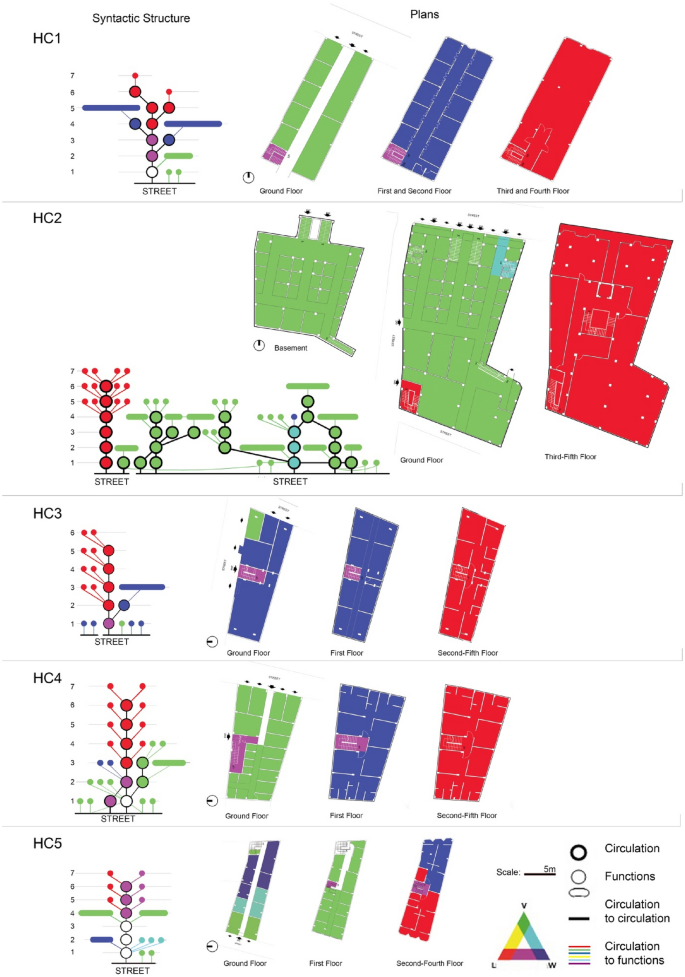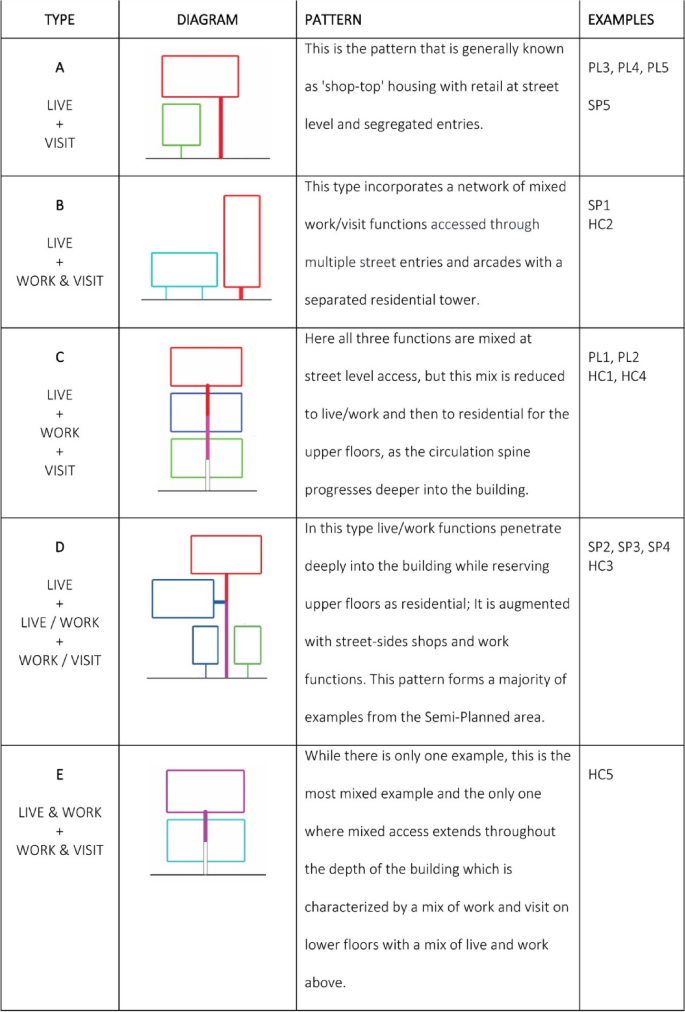- Research article
- Open access
- Published:
Extremes of mixed-use architecture: a spatial analysis of vertical functional mix in Dhaka
City, Territory and Architecture volume 9, Article number: 31 (2022)
Abstract
The concept of mixed-use is now well-established as an urban design and planning principle that adds to the vitality, walkability and productivity of the city at neighbourhood scale. There is much less research on the dense and complex vertical mix of functions within buildings. This paper investigates the extremes of informal vertical mixing of functions within buildings in Dhaka, where commercial and retail functions often penetrate to upper floors and where access routes are often mixed with residential functions. A modified form of space syntax analysis is used to analyse and critique the mix of circulation patterns and functions in 15 complex mixed-use buildings. The plans and relational diagrams reveal how different functions are mixed or separated, and the relative spatial depth they penetrate from the street. Five primary circulation diagrams emerge with different degrees of informality in different districts of the city. Under conditions of informal adaptation, vertical functional mix produces benefits in the form of synergies but also problems of privacy and security. To engage effectively planners need a complex understanding of the interrelated spatial, social and economic logics involved.
Introduction
It is now sixty years since Jacobs (1961) transformed our conceptions of functional mix, suggesting that an understanding of co-functioning was a key to understanding how cities work. She railed against the modernist segregation of the city into mono-functional zones that prevented close connections of home to work, school, shopping and recreation. Functional mix was the antithesis of modernist development that stressed the spatial segregation of urban functions to avoid an undesirable juxtaposition of uses. For Jacobs mixed-use was necessary to the social and economic vitality and intensity of the city; this work has been increasingly embraced in urban planning and functional mix has become a key ingredient of walkability (Grant 2002; Hoppenbrouwer and Louw 2005; Rabianski et al. 2009; Frank et al. 2006; Dovey and Pafka 2020). While most of this research has focused on the neighbourhood scale, it has been understood that functional mix also operates at the building scale. Most notable here is the widespread historic type of shop-house with residential located above retail functions; this building type has long been a staple in South and Southeast Asian cities (Davis 2012; Han and Beisi 2016).
Modernist zoning was invented to solve real problems that can emerge from an unregulated mix of uses. In 2010 and again in 2019 fires have broken out in mixed-use buildings in Old Dhaka, killing a total of 205 people (Imam 2010; Molla 2019). Both fires involved flammable industrial materials stored on lower floors with housing and production work above. These fires were variously blamed on electrical transformers, gas cylinders, chemical storage, building regulators and owners, but also on a more general lack of urban planning controls (Tishi and Islam 2019). In Dhaka, functional mix is widely considered problematic; beyond issues of fire safety, there are perceived problems of visual disorder, privacy and social insecurity (Tishi and Islam 2019; Nahrin 2008). This paper analyses a range of mixed-use buildings in Dhaka to better understand the morphologies of informal mix.
While there is considerable scholarly work on the shop-houses of South and Southeast Asia (Imamuddin et al. 1989; Chun et al. 2005; Phuong and Groves 2010; Su-Jan et al. 2012; Davis 2012) the buildings under discussion here encompass a much denser range of building types. No survey or analysis has been conducted to understand the operation of dense informally mixed buildings such as these. This study explores four principal questions: How are different functions mixed and/or separated within circulation systems of mixed-use buildings? To what relative spatial depth do different functions penetrate from public space and to what height above street level? How are buildings adapted informally to multiple uses and what are the synergies and challenges of such mixing? This paper analyses the functional mix of some of the most extreme of vertically mixed buildings in Dhaka—those that test the limits of functional mixing. These analyses reveal typical circulation patterns and the spatial logic of interrelations between functions, based in the economic and social logic of the city. The paper concludes with a critique of the benefits and challenges of vertical functional mix.
Mixed-use buildings are common in cities of the global South, particularly South and Southeast Asia. The prevalence of functional mix has been noted in Indonesia (Susantono 1998), India (Verma 1993), Vietnam (Phuong and Groves 2010) and Pakistan (Haque 2015, p. 7) where they generally feature high-levels of informal or unregulated mix. More contemporary mixed-use buildings demonstrate new forms of mix, spatial organisation and building morphology in high-density buildings with vertical stacking of wholesale, retail, restaurants, offices, storage, micro-industries and housing (Ujang and Shamsuddin 2008; Tipple et al. 1996).
While Dhaka was always mixed, as the urban density has intensified the mixed-use buildings have grown informally in both extent and functional complexity to meet local demand. Incremental conversion of residential buildings to accommodate workshops, storage, commercial and retail functions are common (Khan 2020, 2021). Access routes into and through mixed-use buildings are adapted where it is possible to separate entrance and circulation for separate uses. However, a singular entrance for residential and non-residential functions is common and can result in privacy, security and safety issues.
Study area and methodology
Dhaka is dominated by informal economic activities and the current land-use of most districts is shown in planning documents as mixed-use (Rajdhani Unnayan Kartripakkha [RAJUK] 2015:38). However, there are also marked differences between the old city, those districts that have developed with a mix of formal and informal planning, and the modernist planned city. These three settlement patterns—historic core, semi-planned and planned—represent key historical phases of urban growth in Dhaka (Fig. 1) and are the most evident morphological patterns in contemporary Dhaka (Nilufar 2011). Figure 2 shows typical streetscapes from mainstreets of each of these three areas. While each is informalised they also represent increasing levels of formalisation. For this study, five mixed-use buildings have been chosen from each of these districts in order to show the range across the city, but also to better understand the extremes of mix within each district.
Dhaka and the three sample districts (Map based on Nilufar 2011; Google Earth)
Islampur in the Historic Core is located at the southern edge of Dhaka. This area has long been the centre for a wide range of wholesale and retail markets with different professional groups who used to live in the shop-houses (Mohsin 1991). A rich mix of uses has been embedded within the fabric of this area since its inception in 1600 and has increased and intensified over time informally into a mix of housing, retail, wholesale, offices, workshops, go-downs (warehouse/shop) and light industries. There were attempts to impose formal land-use planning codes in this district but the state lacked the power to enforce them (Jahan 2011). This zone is seen as most problematic and is the scene of the fires mentioned earlier. The second area, known as Green Road, is a semi-planned neighbourhood near the spatial centre of Dhaka that has developed since the 1960s with a combination of formal and informal street networks. While initially, it was a middle-income residential area, other uses such as shops, workshops and offices have spontaneously developed over time. After 2000, a part of this area was declared commercial, this effectively formalised the mix of functions in those areas, however, non-residential functions in residential areas remain informal. The third area, Uttara, is a planned neighbourhood located on the northern periphery of Dhaka, developed since the 1980s with a regular grid and plot size. Although initially planned as a residential neighbourhood, it has informally developed other functions including shops, cafes, restaurants, and offices over time. Again, mixed functions on the main roads have become authorised over time, while non-residential functions on other streets remain unauthorised. The 5 buildings selected from each of these sites represent a range of mixed-use buildings in each case, but with a focus on denser buildings which test the extremes of mixed-use, avoiding simple low-rise shop-houses.
The method of categorizing building functions deployed here has been adapted from the work of van Hoek (2008) who suggests that urban functions be divided into three primary categories that we call ‘live’, ‘work’, and ‘visit’, plus the various forms of mix that emerge between them (Fig. 3). This live/work/visit model (Dovey and Pafka 2017) is based primarily on the argument that the population in a building, street, or neighbourhood at any particular time can be understood as a mix of those who live there, work there, or visit the place. Most previous studies have considered urban functions in categories such as residential, industrial, commercial, retail, education, entertainment, recreation, health, transport, government, community, parking, vacant, hospitality, etc., which is a modernist way to segregate the city into different categories. Such categorisations are problematic for two major reasons. Firstly, with so many categories/sub-categories, it is difficult to measure and map complex cities with any coherence. Secondly, there is a problem of consistency since the boundaries of any of these categories overlap and can become subsets of another.
The live/work/visit triangle (based on Dovey and Pafka 2017)
This approach is based on a live/work/visit triangle utilizing the points of the triangle for living (red), working (blue) and visiting (green) with the interstitial colours to indicate the different forms of mix between them (Fig. 3). ‘Live’ incorporates places people sleep overnight. ‘Work’ denotes offices, factories and educational spaces. ‘Visit’ is an umbrella concept for places that are primarily used by visitors such as shops, restaurants, libraries, theatres, museums, parks and recreation (Dovey and Pafka 2017). A live/visit mix is represented as yellow; a live/work mix as magenta and a work/visit mix as cyan; a mix of all three will be white. Figure 3 also shows how this method of analysis can be used to show the vertical layering of primary functions of buildings in section and the ways this produces mixed colours when viewed in the plan.
In order to conduct a comparative analysis of the interrelations between functions within each building, we have conducted an adaptation of gamma analysis derived from space syntax analysis. A ‘justified gamma diagram’ is one of the analytical methods developed by Hillier and Hanson (1984) to study the ‘social logic’ of the relationships between spaces within buildings and the depth of those spaces from the street. In this process, architectural plans are translated into diagrams of topological segments (Ostwald 2011: 445; Dovey 2008). Thus the circulation pattern of the building can be identified along with the ways in which the building plan produces separations and intersections between access routes. In the process of the structuring of gamma diagrams, every space in a building is allocated a depth value, according to the minimum number of spatial segments that one must pass through to arrive in that space from the street. These diagrams reduce the plan to a set of spatial segments represented by circles with permeable connections represented by lines. This method produces diagrams of spatial permeability with all spaces of the same depth lined up horizontally at each level away from the street (Hillier and Hanson 1984: 147–149). Because they rely on passing trade, shops are typically one level deep from the street. A stairway between floors is diagrammed as one segment.
Syntactic analysis
This section presents the syntactic analyses of selected buildings from each from the Planned (PL), Semi-Planned (SP) and Historic Core (HC) districts - a sequence of increasing informality and complexity of functional mix. In each case, we show both gamma diagrams and floor plans, colour coded according to the live/work/visit triangle described above. The circles outlined with thick lines represent the main circulation routes of each building; these are also colour coded by the functions to which they give access. In order to make these diagrams readable, clusters of segments with similar functions are represented with elongated boxes to indicate a number of segments in a cluster. The circulation lines are also colour coded by the various uses to which they provide access. A comparative analysis of these gamma diagrams will follow.
We first consider examples from the more recently Planned areas on the urban periphery (Fig. 4) where all buildings were initially designed as mono-functional residential buildings. All 5 examples are 6 storeys high on similar plots; all except the final example have substantial parking at ground level and elevator access to upper floors. The key interest here is in the ways functions have been transformed. PL1 has a central circulation spine that begins with a triple mix (white) of live/work/visit, which gradually becomes live/work (magenta) and then residential (red), as it penetrates deeper into the building. PL2 mixes living, working and visiting on the 4 lower floors; separate shops have emerged on the street frontage of the ground floor which is otherwise devoted to parking. PL3 largely remains mono-functional with just a few shops with separate access at street level. In PL4 and PL5 large portions of ground floor parking have been converted to retail with housing above, but without mixing of entries. This part of Dhaka was planned as mono-functional residential but clearly needs retail to function effectively. Additional visit and work functions that have emerged on upper levels include a dental clinic, school and beauty parlour.
Considering examples from the Semi-Planned area (Fig. 5), SP1 is a 10 storey building that contains two quite separate circulation systems with a complex retail network on the ground floor and housing (with elevator) above. The functional mix is thus confined to the ground floor and basement. SP2 is a 6 storey residential building where office functions have replaced apartments on the 1st and 2nd floors, while retail has separate entries on the street. SP3 is a 4 storey building that is primarily occupied by offices, but mixed with residential on the two middle floors; the main access spine is mostly a live/work mix (magenta). SP4 is a 6 storey building on a street corner with 10 street entries for shops and offices plus a separate entry to the residential floors above. These floors have become mixed with offices up to the 2nd floor. SP5 is a 4 storey building with a mono-functional residential tree-like structure and separate entries for the ground floor shops.
Finally, we consider the more extreme examples from the Historic Core (Fig. 6). HC1 is a 5 storey building entered through a shopping arcade with warehouse/shops (go-downs) on the 1st and second floors and residential above. The circulation has a tree-like structure comprising visit, work, and living at progressive depths. The go-downs extend 5 segments deep while residences extend 7 segments deep. Shops are accessed both from the street and arcade. Mixed circulation is confined to the first three floors and becomes progressively less mixed as it penetrates deeper. HC2 is a 6 storey building with a network of shops on the ground floor, multiple street entries and interconnecting corridors that penetrate up to 6 segments deep. Residential apartments on the 3rd to 5th floors are accessed through a separate stair from the street and have an elevator from the 3rd floor. Here there is a notable contrast between the networked access structure for the shops (with 10 street entries) and a tree-like structure for the housing. HC3 is a 5 storey building with primarily work-related functions (printing) on the ground and first floors with residential above. HC4 is a 6 storey building that combines visit, work and living at progressive levels. It has shops and offices on the ground and first floors with residences above. The mixed circulation penetrates 2 segments deep, moving from a triple mix to live/work and then residential. HC5 is a 5 storey building that mixes retail with work on the first two floors and then work with residential on the three floors above. The single white and magenta access spine indicates that shoppers, workers and residents all use the same access route. Some of the shops (book-binding) are located up to 4 segments deep from the street. The work functions on the upper floors (go-downs) share a kitchen with residential functions. Hence, the combination of working (blue) and living (red) on the upper floors is represented by the mix of live/work access (magenta) on the diagram.
Patterns of Mix
We can see in these examples what may seem a bewildering range of ways in which these buildings mix functions in different ways and to different degrees. While it is not our goal to reduce this field of differences to any kind of essential types, we want to find a way to understand spatial patterns that are evident in this production of vertical mixed-use in buildings. We now take one further step beyond the gamma diagrams to suggest that these mixed-use buildings can be broadly categorised into 5 diagrammatic types with different circulation systems. While the floor areas devoted to different functions are evident on the plans, our primary concern here is to understand the ways mixed-use buildings mix or separate access routes in everyday life. Figure 7 presents a typology of mixed-use buildings representing the typical patterns of vertical mix circulations that are identifiable within the 15 cases. Each of these types is identified first as a relational diagram, followed by a brief description and the examples listed in the final column. In the generic diagrams, the complexities of individual spaces are collapsed in order to reveal spatial clustering by function and connectivity, while also revealing the overall depth or shallowness from the street. In these diagrams, the representation of different functions and their mixes follows the live/work/visit triangular model used earlier in this study. The main circulation spines are represented by thick lines; those with mixed colours (magenta, cyan, white) indicate mixed access spaces.
Figure 7 shows that some types are more common than others, however, this is not a random sample and we are more interested in the range of types. Type A is the vertical mix of live and visit functions often known as ‘shop-top housing’; it is the only type where functions and entries are fully segregated. This is typical in more formal cities and it is not surprising to find it mostly in the Planned Areas. Type B incorporates a complex access network with multiple street entries and arcades giving access to both work and visit functions with separate access to a residential tower above. The mixing of access routes is confined to work/visit which again is typical in more formal cities. Type C is a stack of visiting, working and living functions in a vertical sequence with a single spine of mixed access. Thus all three functions are mixed at street level, but this mix is reduced to live/work and then to residential for the upper floors, as the circulation spine progresses deeper into the building. This type is mostly produced by the informal adaptation of residential buildings. Type D is similar but with retail and some work functions separated at street level - thus there is no mixing of retail and residential access. While there is only one example of type E in our study, this is the most mixed example and the only one without any mono-functional access—mixed access extends throughout the depth of the 5 storey building.
These generic syntactic diagrams demonstrate that visiting, working and living functions generally remain in a consistent sequence of progressive depth in buildings. Shops typically remain at the shallowest position, as they depend on accessibility for their business. They often extend deep into ground floor plans and sometimes to the 1st and 2nd floors. Work functions are often mixed with shops on the ground floor but more commonly extend to intermediate floors as in types C and D. Residential functions always occupy the deepest and most private sector of the building. Figure 7 also shows the ways the different types are distributed across the three areas of the city from which examples were chosen. In general terms, the Historic Core has more complex and mixed examples while the Planned areas have more segregated functions. This reflects the fact that the Historic Core has always been mixed while buildings in the Planned and Semi-Planned areas were initially designed as mono-functional and have become informally mixed over time.
Discussion
In this study, we have mapped and analysed functional mix within selected buildings of an extremely mixed informal city. These examples are not random nor typical, they have been chosen as the most mixed cases in each study area because they embody this extreme and test the limits of functional mixing within buildings. These buildings have been analysed through methods that reveal typical circulation patterns and the mixing of different functions within them. While the building plans and syntactic diagrams are empirically interesting (Figs. 4, 5 and 6), the key findings of the paper lie in the generic diagrams that reveal broader patterns of vertical mix and circulation systems (Fig. 7). This work also enables further critique on the benefits and challenges of different forms of vertical functional mix. It is not our purpose here to make judgements about the effectiveness or otherwise of different kinds of functional mix based on this data, however, it is possible to discern a certain spatial logic, linked to the economic and social logic of the city.
While these mixed-use buildings involve challenges at the micro-scale of storage of noxious materials and social encounters, it also has significant benefits at the broader scale. Informal adaptation to a greater mix serves city dwellers by filling the gaps between demand and available services; in this way, the mix contributes to the local economy. The informal conversions are generating a more walkable and lively urban environment by integrating diverse functions, activities and people—a quality that is often missing in the modernist planned areas. While this city clearly needs greater regulation, these neighbourhoods are more walkable and efficient because of the mix and would be quite dysfunctional without it.
When we look at the circulation spaces of the syntactic diagrams we note a considerable amount of mixing of work/visit (cyan) and work/live (magenta), a few spaces that mix all three functions (white), but never live/visit (yellow). In other words, whenever residential access becomes mixed it is always mixed with production functions first and only occasionally with shopping as well. There are clear synergies in the mixing of work and visit functions that are not present when either of these functions is mixed with residential. These are not the kinds of synergy that originally drove the proliferation of the shophouse where one lived over the store and often entered the home through it (Davis 2012). Thus the synergy between residential and retail that produces shop-top housing—the form of functional mix that works so well in almost any highly urbanized city—depends on a separation of these functions within each building.
The issues of functional mix cannot be considered separately from the range of morphological factors that frame the ways it emerges; particularly in relation to street interface conditions and density. The capacity to design separate access routes into each building depends to a significant degree on the capacity for multiple street entries—the cases in our sample range from 3 to 11 street entries each with an average of 4–6. This capacity will depend in turn on plot size and block location—a larger plot size and corner location produce more capacity for multiple street entries. Figures 4, 5 and 6 show that the more informal districts have a much less regular plot size and shape, with a greater average and range of street entries. By contrast, significant parts of the street frontage in the planned area are consumed by carpark entries. In general, the unplanned areas have a greater capacity to produce separated entries.
The issues and challenges that emerge in relation to an extreme functional mix cannot be extricated from questions of density. The buildings we have considered range from 4 to 10 storeys; plot coverage in most cases is close to 100% and net floor area ratios range from 2.8 to 6.0. While these building densities are not uncommon in Dhaka, they are very high by global standards (Dovey and Pafka 2014). Population densities are also extremely high, whether in terms of residential populations, jobs or streetlife—the same live/work/visit categories used for the functional analysis. Many of these internal spaces have very high population densities in terms of overcrowded housing, offices, workshops and shops. It is important to understand that a problem that may appear to be caused by the mix, may not be a problem at a lower density; it is not just the fact of mixing different populations within circulation spaces but the intensity of this mix.
Many of these buildings, especially in the Planned district, were originally designed as mono-functional but have been informally adapted to various forms of mixed-use. The key dynamic here has been one of residential space converted to workshops, offices, shops, schools and so on. While shops and offices may be interconvertible, there are no examples of them being converted into apartments. It is clear that economic forces are the key drivers—work and visit functions bring higher rents in those spaces closer to the street. Depending on the ways in which the building was initially designed, it will have varying levels of capacity to adapt. If there is a single circulation spine and no space for additional entries then such entry spaces will be mixed. This will reduce the amenity and security of all remaining residential apartments, also reducing the rental value and increasing affordability. Thus the functional mix within buildings is linked to the socio-economic profile of residents.
The two greatest challenges embodied in the extreme forms of vertical mix we have documented here are the risk of fire and the social difficulties of shared access. The deadly fires that have occurred in Dhaka are often seen as due to an incompatible mix of functions, where noxious or dangerous materials are stored in spaces where any resulting fire is difficult to control or escape from. However, this problem could be addressed through stricter control of storage, workplace safety and fire egress without changing the functional mix. The challenge here is partly local because there is such a strong tradition of the go-down—the small shop that is also a warehouse.
The social issues that mixed-use functions usually cause are privacy and security. The informal transformation of residential buildings from mono-functional to mixed-use often generates shared circulation spaces where public access penetrates deeply into the upper floors, compromising the privacy and security of residences. It is imperative that work and visit functions achieve this public access for their business. The gamma diagrams in Figs. 4, 5 and 6 show these levels of penetration graphically; they also show that even the most dense and complex buildings can be designed with segregated access.
In as much as mono-functional planning has been damaging to the city, the adaptation of residential buildings to mixed-use functions is a benefit. The planning challenge lies not in micro-managing what the mix should be but in protecting citizens from negative outcomes. The formal controls of the state should focus on proscribing certain outcomes rather than prescribing particular functions. It is important to acknowledge the benefits of informal adaptation within a formal planning framework. It is also necessary to identify and address the key problems related to informal mix in buildings. The control of mixed entries is a complex issue that requires a better understanding of the relations between formal and informal processes in any city. While the separation of residential entries is generally preferable, there may be advantages in blurring the boundaries between home and work - as is happening in more formal cities. Housing that is entered through mixed entry spaces may have difficulties in terms of privacy and security that other housing does not, however, it will also be more affordable and adaptable. It is not the role of the state to enforce the segregation of entries. The broad challenge, both in Dhaka and other highly informalised cities of the global South, is to develop forms of urban planning that can address the challenges of a dysfunctional mix without destroying the vitality and productivity of the mixed-use district.
References
Chun HK, Hassan AS, Noordin NM (2005) An Influence of Colonial Architecture to Building Styles and Motifs in Colonial Cities in Malaysia. Paper presented at the 8th International Conference of the Asian Planning Schools Association, Penang, 12–14 September 2005
Davis H (2012) Living over the store. Routledge, London
Dovey K (2008) Framing places. Routledge, London
Dovey K, Pafka E (2014) The urban density assemblage. Urban Des Int 19(1):66–76
Dovey K, Pafka E (2017) What is functional mix? Plann Theory Pract 18(2):249–267
Dovey K, Pafka E (2020) What is walkability? The urban DMA. Urban Stud 57(1):93–108
Frank LD, Sallis JF, Conway TL et al (2006) Many pathways from land use to health: associations between neighborhood walkability and active transportation, body mass index, and air quality. J Am Plann Assoc 72(1):75–87
Grant J (2002) Mixed use in theory and practice. J Am Plann Assoc 68(1):71–84
Han W, Beisi J (2016) Urban morphology of commercial port cities and shop-houses in Southeast Asia. Proc Eng 142:189–196
Haque NU (2015) Flawed urban development policies in Pakistan. PIDE working paper 119, Pakistan Institute of Development Economics, Islamabad
Hillier B, Hanson J (1984) The social logic of space. Cambridge University Press, Cambridge
Hoek JW van den (2008) The MXI (Mixed-use Index) as tool for urban planning and analysis. Corporations and Cities, Delft University of Technology 1–15
Hoppenbrouwer E, Louw E (2005) Mixed-use development. Eur Plan Stud 13(7):967–983
Imam H (2010) Nimtoli tragedy: the worst nightmare. In: The Daily Star, 12 June. https://www.thedailystar.net/news-detail-142316. Accessed 30 Apr 2021
Imamuddin AH, Hassan SA, Alam W (1989) Shakhari Patti: a unique old city settlement, Dhaka. Protibesh, Bangladesh University of Engineering and Technology (BUET) lll(2)
Jacobs J (1961) The death and life of great American cities. Vintage Books, New York
Jahan S (2011) Dhaka: an urban planning perspective. In: Ahmed S, Hafiz R, Rabbani A (eds) 400 years of capital Dhaka and beyond, vol 3: The Asiatic Society of Bangladesh, Dhaka
Khan FM (2020) Functional mix and changing morphology of Dhaka. PhD Thesis, University of Melbourne
Khan FM, Pafka E, Dovey K (2021) Understanding informal functional mix: morphogenic mapping of Old Dhaka. J Urban Int Res Placemaking Urban Sustain. https://doi.org/10.1080/17549175.2021.1979085
Mohsin KM (1991) Commercial and industrial aspects of Dhaka in the eighteenth century. In: Ahmed SU (ed) Dhaka past present future. The Asiatic Society of Bangladesh, Dhaka
Molla MAM (2019) Nimtoli to Chawkbazar. In: The Daily Star, 22 February. https://www.thedailystar.net/frontpage/news/dhaka-fire-nimtoli-chawkbazar-lesson-not-learnt-1705771. Accessed 30 Apr 2021
Nahrin K (2008) Violation of land use plan and its impact on community life in Dhaka city. Jahangirnagar Plann Rev 6:39–47
Nilufar F (2011) Urban morphology of Dhaka city: spatial dynamics of growing city and the urban core. In: Ahmed S, Hafiz R, Rabbani A (eds) 400 years of capital Dhaka and beyond, vol 3: The Asiatic Society of Bangladesh, Dhaka
Ostwald MJ (2011) The mathematics of spatial configuration. Nexus Netw J 13(2):445–470
Phuong DQ, Groves D (2010) Sense of place in Hanoi’s shop-house. J Interior Des 36(1):1–20
Rabianski JS, Gibler K, Tidwell OA, Clements JS (2009) Mixed-use development. J Real Estate Lit 17(2):205–230
Rajdhani Unnayan Kartripakkha—RAJUK (2015) Dhaka Structure Plan: 2016–2035. Dhaka. (http://www.rajukdhaka.gov.bd/rajuk/image/slideshow/5.Chapter%2002.pdf)
Su-Jan Y, Limin H, Kiang H (2012) Urban informality and everyday (night) life: a Field Study in Singapore. Int Dev Plann Rev 34(4):369–390
Susantono B (1998) Transportation land use dynamics in metropolitan Jakarta. Berkeley Plann J 12(1):126–144
Tipple AG, Kellett PW, Masters GA (1996) Mixed use in residential areas. Final report for ODA research project 6265, Centre for Architectural Research and Development Overseas. University of Newcastle upon Tyne
Tishi TR, Islam I (2019) Urban fire occurrences in the Dhaka Metropolitan Area. Geo J 84(3):1417–1427
Ujang N, Shamsuddin S (2008) Place attachment in relation to users’ roles in the main shopping streets of Kuala Lumpur. In: Bashri A, Mai MM (eds) Urban design issues in the developing world. Universiti Teknologi Malaysia, Malaysia
Verma DG (1993) Inner city renewal: lessons from the Indian experience. Habitat Int 17(1):117–132
Author information
Authors and Affiliations
Contributions
All authors have taken part in writing the manuscript. All authors read and approved the final manuscript.
Authors information
Fatema Meher Khan is an Assistant Professor at the Department of Architecture at the Bangladesh University of Engineering and Technology (BUET). Her research interest lies in urban design and planning, morphological aspects, and informal urbanism. Some of her research papers are on mixed-use function, urban morphological transformation, and social equity. Elek Pafka is Senior Lecturer in Urban Planning and Urban Design at the Faculty of Architecture, Building and Planning at the University of Melbourne. His research focuses on the relationship between material density, urban form and the intensity of urban life, as well as methods of mapping the ‘pulse’ of the city. He has participated in research on transit oriented development, functional mix and walkability. He has co-edited the book Mapping Urbanities: Morphologies, Flows, Possibilities. Kim Dovey is Professor of Architecture and Urban Design at the University of Melbourne, where he is also Director of InfUr- the Informal Urbanism Research Hub. He has published and broadcast widely on social issues in architecture, urban design and planning. Books include 'Framing Places', 'Fluid City', ‘Becoming Places’, ‘Urban Design Thinking’ and ‘Mapping Urbanities'.
Corresponding author
Additional information
Publisher’s Note
Springer Nature remains neutral with regard to jurisdictional claims in published maps and institutional affiliations.
Rights and permissions
Open Access This article is licensed under a Creative Commons Attribution 4.0 International License, which permits use, sharing, adaptation, distribution and reproduction in any medium or format, as long as you give appropriate credit to the original author(s) and the source, provide a link to the Creative Commons licence, and indicate if changes were made. The images or other third party material in this article are included in the article's Creative Commons licence, unless indicated otherwise in a credit line to the material. If material is not included in the article's Creative Commons licence and your intended use is not permitted by statutory regulation or exceeds the permitted use, you will need to obtain permission directly from the copyright holder. To view a copy of this licence, visit http://creativecommons.org/licenses/by/4.0/.
About this article
Cite this article
Khan, F.M., Pafka, E. & Dovey, K. Extremes of mixed-use architecture: a spatial analysis of vertical functional mix in Dhaka. City Territ Archit 9, 31 (2022). https://doi.org/10.1186/s40410-022-00177-y
Received:
Accepted:
Published:
DOI: https://doi.org/10.1186/s40410-022-00177-y
